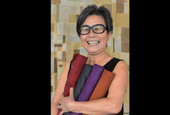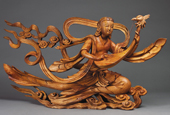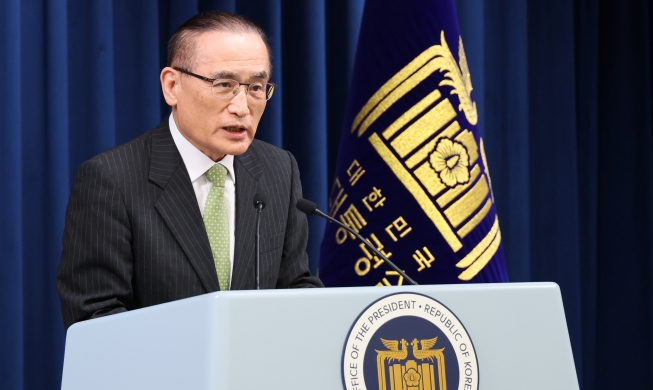Last December, an artist became the first Korean winner of the grand prize at the Société des Artistes Indépendants, the Society of Independent Artists, held in the Grand Palais in Paris, France. The show was hosted by the Amitiés internationales André Malraux, a cultural association established in 1996 in remembrance of the literary giant André Malraux. Since its inception, the association has regularly invited distinguished artists worldwide to show their art and has awarded them with a prize for their excellent work.
Last year’s honor went to Korean artist Park Ju-kyong. “First, I was very pleased that my work had been on display at the Grand Palais. Then I heard the news that I had won the grand prize. I was so thrilled. It is such a great honor.” Park’s winning picture, “Citizen,” was created using artist knives instead of brushes.
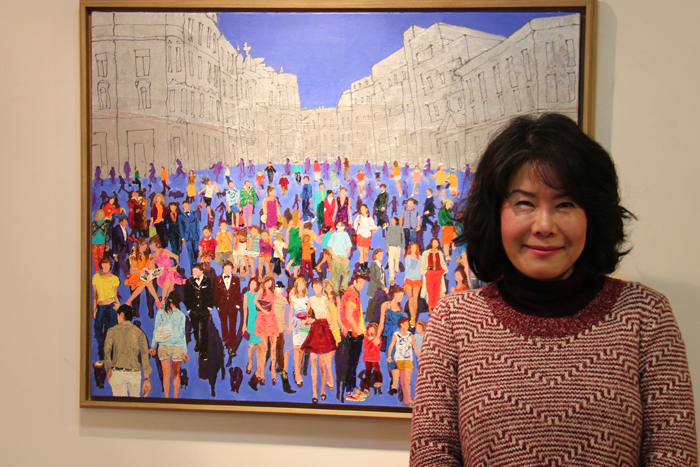
Park has come under the spotlight for another reason, too. She has another job, other than being an artist. She is a firefighter. She is the chief of a disaster response team in Yongsan-gu (Yongsan District), Seoul. She landed the job in 1984 and has since built up a career path of over 30 years.
“The dangerous activities that I have to go through as a firefighter give me fresh inspiration and inspire the motif for my new pieces. The other way around, the artistic activities instill in me vigorous energy and give me encouragement in my working life,” Park said.
Korea.net met with the artist to hear her interesting life story.
Q: You seem to have a very interesting background. It seems contradictory to have both jobs at once. As a firefighter, you need a lot of energy and have to be physically trained whereas you need an artistic sensibility as an artist. How did you come to land both jobs?
A: I was recruited as an officer in the fire service in 1984 when I was in my first year of university. Now, I work with all of Yongsan-gu’s fire and emergency services, called to the scene during disasters. However, during that time, I started my career as an artist in 1990. So far, I’ve taken part in around 220 exhibitions, including 13 private exhibitions and a variety of overseas and domestic art fairs.
My life can be defined with just two things: my job as a firefighter and the art for which I feel a passion. It has become my routine, over the past 30 years of life, that as soon as I leave my workplace, I devote everything to the painting. I always have to split my after-work hours. Normally, I focus on painting for three to four hours on average per day. Whenever I happen to waste my time, even an hour or two, I get really upset at myself and my pulse quickens. If I don’t paint even for a day, I just can’t stand the feeling that my hands will go stiff. If I didn’t feel interested in or excited about the painting, I wouldn’t have been able to make it.
Q: “Passion” is probably the only word that can explain your life. What attracts you so much to painting?
A: I began painting when I was young. I preferred painting portraits instead of anything else. When I was a student at the Wonju Women’s High School, my classmates would always line up in front of me during break time to have their portraits painted. I wanted to major in fine arts, but family circumstances forced me to give it up. I ended up majoring in French literature. As soon as I entered university, I was joined up with a couple of other friends who also dreamed of being artists, and we got a painting studio of our own. Most of my time was spent shuttling between my school and the studio.
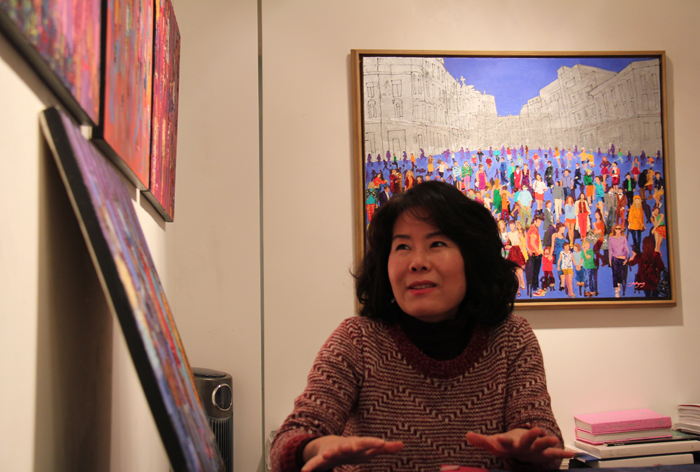
Q: Isn’t it tough having two jobs at once?
A: Both are important to me. I thought I would never have been able to paint the winning piece, not without all the technique and know-how built up over 30 years. It would have been impossible if I was a full-time painter.
Q: “Citizen,” the winning piece of the Société des Artistes Indépendants, was praised in that it feels like it draws people into the midst of the crowd in the painting. What message did you intend to deliver?
A: The main theme is just the citizens and their daily lives. The “Citizen” series consists of several pieces: Temptation, Urban male and female, Desire and three more. The city we are living in has a countless number of citizens. They might look glamorous, calm and peaceful, but every single citizen will have inner tensions, anxieties and lonely feelings of their own. I intended to shed light on these aspects of a multi-colored city and the “life” of the people. The use of a knife, rather than a brush, might have probably provided a stronger impression.
Q: A strong sense of femininity seems to be embedded in your painting. Have you been drawn by any particular inspiration by any chance?
A: You would be able to find silhouettes of walking humans here and there, in between the empty spaces and in the background of the painting. I was inspired by the image of the Beatles walking across a crosswalk. The Beatles are the icon of the 1960s, whose music inspired youth worldwide to dream about freedom. In my eyes, the Beatles played a role in breaking up the Cold War and in opening a new world for women to enjoy the peace, freedom, desire and consumption they enjoy today.
I put an emphasis on women. They, who have been kept down throughout history, are now able to walk across the street with their heads held high, consume what they want and play a role in society. I thought the changed lifestyle of women is certainly the proper medium to express the liberalism, capitalism and materialism that the Beatles sought.
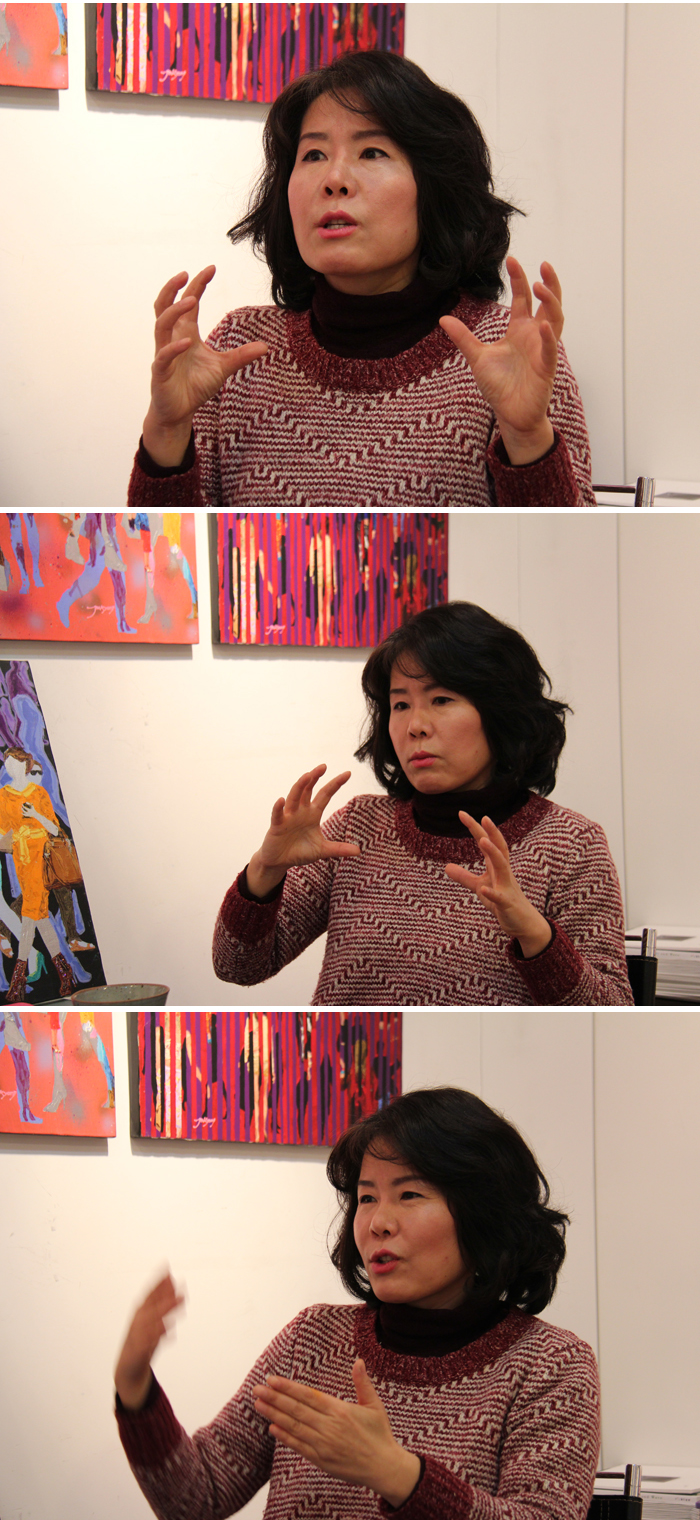
Q: A student who majored in French literature turned to the job of a firefighter and then works as a painter at the same time. It sounds like a novel. Without taking part in regular art classes, how did you come to all this? From where do you mainly get your inspiration?
A: Except for during exhibitions, over the past 30 years I have never stopped going outside to make a few sketches. I am always moved by the greatness of nature and the vitality of living creatures which lifts my heart and makes it likely to explode. It is something that I can only achieve when sketching. The emotions I have can perfectly be transferred onto my canvas. I am happy at that moment.
Q: Your fans probably look forward to seeing your next work. What are your future plans?
A: Once I take an interest in something, I become crazy about it. At the moment, I am concentrating on a new series about “Nudity in Black.” I want to express how powerful the visual effect is. It began with my personal inquiries. Concerning race, why are darker-skinned people sometimes discriminated against? Concerning vanity, aging is such a natural phenomenon, but why do people have to shy away from their hair going grey white?
Through my painting, I would like to say that we have to care about the color of red, a symbol of “freshness” or “healthiness.” I would like to have the message in my paintings that it is such a fool’s errand to only seek a perfect outer appearance while all their blood gets thick and blackens due to their careless eating habits or behavior.
By Lee Seung-ah
Korea.net Staff Writer
slee27@korea.kr
Last year’s honor went to Korean artist Park Ju-kyong. “First, I was very pleased that my work had been on display at the Grand Palais. Then I heard the news that I had won the grand prize. I was so thrilled. It is such a great honor.” Park’s winning picture, “Citizen,” was created using artist knives instead of brushes.

Park Ju-kyong, working as both a firefighter and an artist, tells her novel-like life story. The picture in the background is her prize-winning piece “Citizen.” (photo: Wi Tack-whan)
Park has come under the spotlight for another reason, too. She has another job, other than being an artist. She is a firefighter. She is the chief of a disaster response team in Yongsan-gu (Yongsan District), Seoul. She landed the job in 1984 and has since built up a career path of over 30 years.
“The dangerous activities that I have to go through as a firefighter give me fresh inspiration and inspire the motif for my new pieces. The other way around, the artistic activities instill in me vigorous energy and give me encouragement in my working life,” Park said.
Korea.net met with the artist to hear her interesting life story.
Q: You seem to have a very interesting background. It seems contradictory to have both jobs at once. As a firefighter, you need a lot of energy and have to be physically trained whereas you need an artistic sensibility as an artist. How did you come to land both jobs?
A: I was recruited as an officer in the fire service in 1984 when I was in my first year of university. Now, I work with all of Yongsan-gu’s fire and emergency services, called to the scene during disasters. However, during that time, I started my career as an artist in 1990. So far, I’ve taken part in around 220 exhibitions, including 13 private exhibitions and a variety of overseas and domestic art fairs.
My life can be defined with just two things: my job as a firefighter and the art for which I feel a passion. It has become my routine, over the past 30 years of life, that as soon as I leave my workplace, I devote everything to the painting. I always have to split my after-work hours. Normally, I focus on painting for three to four hours on average per day. Whenever I happen to waste my time, even an hour or two, I get really upset at myself and my pulse quickens. If I don’t paint even for a day, I just can’t stand the feeling that my hands will go stiff. If I didn’t feel interested in or excited about the painting, I wouldn’t have been able to make it.
Q: “Passion” is probably the only word that can explain your life. What attracts you so much to painting?
A: I began painting when I was young. I preferred painting portraits instead of anything else. When I was a student at the Wonju Women’s High School, my classmates would always line up in front of me during break time to have their portraits painted. I wanted to major in fine arts, but family circumstances forced me to give it up. I ended up majoring in French literature. As soon as I entered university, I was joined up with a couple of other friends who also dreamed of being artists, and we got a painting studio of our own. Most of my time was spent shuttling between my school and the studio.

Artist Park Ju-kyong says, “I stick to what I can do in order to do what I have a passion for.” (photo: Wi Tack-whan)
Q: Isn’t it tough having two jobs at once?
A: Both are important to me. I thought I would never have been able to paint the winning piece, not without all the technique and know-how built up over 30 years. It would have been impossible if I was a full-time painter.
Q: “Citizen,” the winning piece of the Société des Artistes Indépendants, was praised in that it feels like it draws people into the midst of the crowd in the painting. What message did you intend to deliver?
A: The main theme is just the citizens and their daily lives. The “Citizen” series consists of several pieces: Temptation, Urban male and female, Desire and three more. The city we are living in has a countless number of citizens. They might look glamorous, calm and peaceful, but every single citizen will have inner tensions, anxieties and lonely feelings of their own. I intended to shed light on these aspects of a multi-colored city and the “life” of the people. The use of a knife, rather than a brush, might have probably provided a stronger impression.
Q: A strong sense of femininity seems to be embedded in your painting. Have you been drawn by any particular inspiration by any chance?
A: You would be able to find silhouettes of walking humans here and there, in between the empty spaces and in the background of the painting. I was inspired by the image of the Beatles walking across a crosswalk. The Beatles are the icon of the 1960s, whose music inspired youth worldwide to dream about freedom. In my eyes, the Beatles played a role in breaking up the Cold War and in opening a new world for women to enjoy the peace, freedom, desire and consumption they enjoy today.
I put an emphasis on women. They, who have been kept down throughout history, are now able to walk across the street with their heads held high, consume what they want and play a role in society. I thought the changed lifestyle of women is certainly the proper medium to express the liberalism, capitalism and materialism that the Beatles sought.

Artist Park Ju-kyong talks about her winning piece “Citizen.” (photos: Wi Tack-whan)
Q: A student who majored in French literature turned to the job of a firefighter and then works as a painter at the same time. It sounds like a novel. Without taking part in regular art classes, how did you come to all this? From where do you mainly get your inspiration?
A: Except for during exhibitions, over the past 30 years I have never stopped going outside to make a few sketches. I am always moved by the greatness of nature and the vitality of living creatures which lifts my heart and makes it likely to explode. It is something that I can only achieve when sketching. The emotions I have can perfectly be transferred onto my canvas. I am happy at that moment.
Q: Your fans probably look forward to seeing your next work. What are your future plans?
A: Once I take an interest in something, I become crazy about it. At the moment, I am concentrating on a new series about “Nudity in Black.” I want to express how powerful the visual effect is. It began with my personal inquiries. Concerning race, why are darker-skinned people sometimes discriminated against? Concerning vanity, aging is such a natural phenomenon, but why do people have to shy away from their hair going grey white?
Through my painting, I would like to say that we have to care about the color of red, a symbol of “freshness” or “healthiness.” I would like to have the message in my paintings that it is such a fool’s errand to only seek a perfect outer appearance while all their blood gets thick and blackens due to their careless eating habits or behavior.
By Lee Seung-ah
Korea.net Staff Writer
slee27@korea.kr
